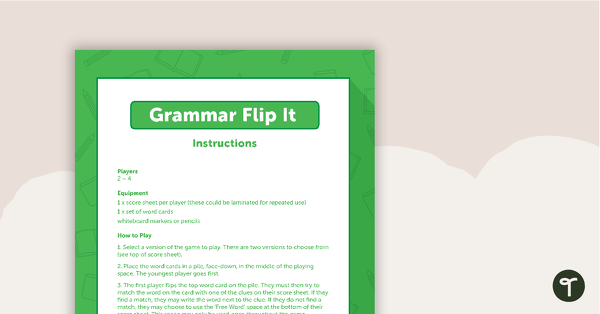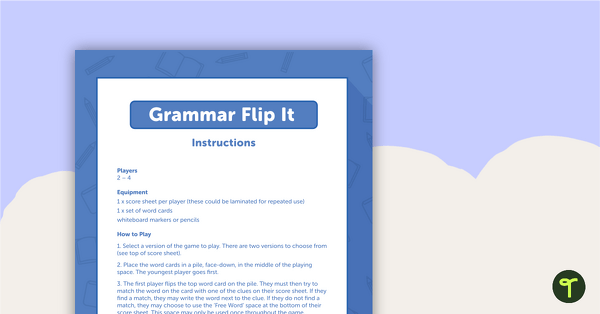A poster explaining how to activate prior knowledge before reading.
Display this teaching resource in your classroom to remind students how to activate their prior knowledge before reading.
Updated: 14 Jun 2018
A poster explaining how to activate prior knowledge before reading.
Non-Editable: PDF
Pages: 1 Page
Years: F - 7
Use comprehension strategies, such as visualising, predicting, connecting, summarising and questioning, and draw on learnt vocabulary and growing knowledge of context and text structures to build literal and inferred meanings
Use comprehension strategies, such as visualising, predicting, connecting, summarising, monitoring and questioning, and begin to analyse texts by drawing on a growing knowledge of context and text structures to build literal and inferred meaning...
Use comprehension strategies, such as visualising, predicting, connecting, summarising, monitoring and questioning, to analyse texts by drawing on a growing knowledge of context, text structures and language features to build literal and inferre...
Use comprehension strategies, such as visualising, predicting, connecting, summarising, monitoring and questioning, to expand topic knowledge and ideas, and begin to evaluate texts to build literal and inferred meanings
Use comprehension strategies, such as visualising, predicting, connecting, summarising, monitoring and questioning, to evaluate information and ideas to build literal and inferred meanings
Use comprehension strategies, such as visualising, predicting, connecting, summarising, monitoring and questioning, and connect and compare ideas from a variety of sources to build literal and inferred meanings
Comprehends independently read texts that require sustained reading by activating background and word knowledge, connecting and understanding sentences and whole text, and monitoring for meaning
Builds knowledge and use of Tier 1, Tier 2 and Tier 3 vocabulary through interacting, wide reading and writing, and by defining and analysing words
Fluently reads and comprehends texts for wide purposes, analysing text structures and language, and by monitoring comprehension
Plans, creates and revises written texts for multiple purposes and audiences through selection of text features, sentence-level grammar, punctuation and word-level language
Analyses representations of ideas in literature through genre and theme that reflect perspective and context, argument and authority, and adapts these representations when creating texts
Use comprehension strategies to understand and discuss texts listened to, viewed or read independentlyElaborationstalking about the meanings in texts listened to, viewed and read (Skills: Literacy, Critical and Creative Thinking)visualising elements ...
Use comprehension strategies to build literal and inferred meaning about key events, ideas and information in texts that they listen to, view and read by drawing on growing knowledge of context, text structures and language featuresElaborationsusing ...
Use comprehension strategies to build literal and inferred meaning and begin to analyse texts by drawing on growing knowledge of context, language and visual features and print and multimodal text structuresElaborationsmaking connections between the ...
Use comprehension strategies to build literal and inferred meaning and begin to evaluate texts by drawing on a growing knowledge of context, text structures and language featuresElaborationsmaking connections between the text and students own experie...
Use comprehension strategies to build literal and inferred meaning to expand content knowledge, integrating and linking ideas and analysing and evaluating textsElaborationsmaking connections between the text and studentsâ own experience and oth...
Use comprehension strategies to analyse information, integrating and linking ideas from a variety of print and digital sourcesElaborationsusing research skills including identifying research purpose, locating texts, gathering and organising informati...
Use comprehension strategies to interpret and analyse information and ideas, comparing content from a variety of textual sources including media and digital textsElaborationsmaking connections between the text and studentsâ own experience or oth...
Use comprehension strategies such as visualising, predicting, connecting, summarising and questioning when listening, viewing and reading to build literal and inferred meaning by drawing on vocabulary and growing knowledge of context and text structures
Use comprehension strategies such as visualising, predicting, connecting, summarising, monitoring and questioning to build literal and inferred meaning
Use comprehension strategies when listening and viewing to build literal and inferred meaning, and begin to evaluate texts by drawing on a growing knowledge of context, text structures and language features
Use comprehension strategies such as visualising, predicting, connecting, summarising, monitoring and questioning to build literal and inferred meaning, to expand topic knowledge and ideas, and evaluate texts
Use comprehension strategies such as visualising, predicting, connecting, summarising, monitoring and questioning to build literal and inferred meaning to evaluate information and ideas
Use comprehension strategies such as visualising, predicting, connecting, summarising, monitoring and questioning to build literal and inferred meaning, and to connect and compare content from a variety of sources

A poster explaining how to activate prior knowledge before reading.
Display this teaching resource in your classroom to remind students how to activate their prior knowledge before reading.
Use comprehension strategies, such as visualising, predicting, connecting, summarising and questioning, and draw on learnt vocabulary and growing knowledge of context and text structures to build literal and inferred meanings
Use comprehension strategies, such as visualising, predicting, connecting, summarising, monitoring and questioning, and begin to analyse texts by drawing on a growing knowledge of context and text structures to build literal and inferred meaning...
Use comprehension strategies, such as visualising, predicting, connecting, summarising, monitoring and questioning, to analyse texts by drawing on a growing knowledge of context, text structures and language features to build literal and inferre...
Use comprehension strategies, such as visualising, predicting, connecting, summarising, monitoring and questioning, to expand topic knowledge and ideas, and begin to evaluate texts to build literal and inferred meanings
Use comprehension strategies, such as visualising, predicting, connecting, summarising, monitoring and questioning, to evaluate information and ideas to build literal and inferred meanings
Use comprehension strategies, such as visualising, predicting, connecting, summarising, monitoring and questioning, and connect and compare ideas from a variety of sources to build literal and inferred meanings
Comprehends independently read texts that require sustained reading by activating background and word knowledge, connecting and understanding sentences and whole text, and monitoring for meaning
Builds knowledge and use of Tier 1, Tier 2 and Tier 3 vocabulary through interacting, wide reading and writing, and by defining and analysing words
Fluently reads and comprehends texts for wide purposes, analysing text structures and language, and by monitoring comprehension
Plans, creates and revises written texts for multiple purposes and audiences through selection of text features, sentence-level grammar, punctuation and word-level language
Analyses representations of ideas in literature through genre and theme that reflect perspective and context, argument and authority, and adapts these representations when creating texts
Use comprehension strategies to understand and discuss texts listened to, viewed or read independentlyElaborationstalking about the meanings in texts listened to, viewed and read (Skills: Literacy, Critical and Creative Thinking)visualising elements ...
Use comprehension strategies to build literal and inferred meaning about key events, ideas and information in texts that they listen to, view and read by drawing on growing knowledge of context, text structures and language featuresElaborationsusing ...
Use comprehension strategies to build literal and inferred meaning and begin to analyse texts by drawing on growing knowledge of context, language and visual features and print and multimodal text structuresElaborationsmaking connections between the ...
Use comprehension strategies to build literal and inferred meaning and begin to evaluate texts by drawing on a growing knowledge of context, text structures and language featuresElaborationsmaking connections between the text and students own experie...
Use comprehension strategies to build literal and inferred meaning to expand content knowledge, integrating and linking ideas and analysing and evaluating textsElaborationsmaking connections between the text and studentsâ own experience and oth...
Use comprehension strategies to analyse information, integrating and linking ideas from a variety of print and digital sourcesElaborationsusing research skills including identifying research purpose, locating texts, gathering and organising informati...
Use comprehension strategies to interpret and analyse information and ideas, comparing content from a variety of textual sources including media and digital textsElaborationsmaking connections between the text and studentsâ own experience or oth...
Use comprehension strategies such as visualising, predicting, connecting, summarising and questioning when listening, viewing and reading to build literal and inferred meaning by drawing on vocabulary and growing knowledge of context and text structures
Use comprehension strategies such as visualising, predicting, connecting, summarising, monitoring and questioning to build literal and inferred meaning
Use comprehension strategies when listening and viewing to build literal and inferred meaning, and begin to evaluate texts by drawing on a growing knowledge of context, text structures and language features
Use comprehension strategies such as visualising, predicting, connecting, summarising, monitoring and questioning to build literal and inferred meaning, to expand topic knowledge and ideas, and evaluate texts
Use comprehension strategies such as visualising, predicting, connecting, summarising, monitoring and questioning to build literal and inferred meaning to evaluate information and ideas
Use comprehension strategies such as visualising, predicting, connecting, summarising, monitoring and questioning to build literal and inferred meaning, and to connect and compare content from a variety of sources

We create premium quality, downloadable teaching resources for primary/elementary school teachers that make classrooms buzz!
Would you like something changed or customised on this resource? While our team makes every effort to complete change suggestions, we can't guarantee that every change will be completed.
Did you spot an error on this resource? Please let us know and we will fix it shortly.
Are you having trouble downloading or viewing this resource? Please try the following steps:
If you are still having difficulty, please visit the Teach Starter Help Desk or contact us .

A fun game for students to play in small groups to consolidate their understanding of adjectives.

A fun game for students to play in small groups to consolidate their understanding of verbs.

A sheet of letters to use when making CVC words.

Use this set of Year 1 editing passages to help your students demonstrate their spelling, punctuation and grammar knowledge.

A NAPLAN-style rubric designed to help teachers to assess student's poetry.

Use this set of Year 2 editing passages to help your students demonstrate their spelling, punctuation and grammar knowledge.

Use this set of Year 4 editing passages to help your students demonstrate their spelling, punctuation and grammar knowledge.

A set of 28 generic QAR question cards for students to use as a comprehension task after reading.

Get your students using this editing checklist so that no mistake gets left behind!

A worksheet for beginner writers to practice their handwriting.
0 Comments
Write a review to help other teachers and parents like yourself. If you'd like to request a change to this resource, or report an error, select the corresponding tab above.